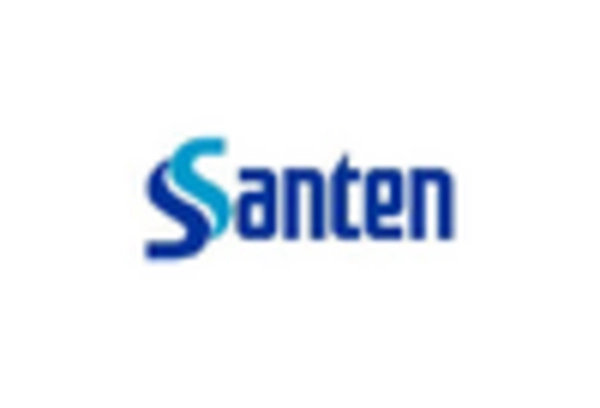Rising Prevalence of Glaucoma
The increasing incidence of glaucoma, a leading cause of irreversible blindness, is a primary driver for the Novel Drug and Devices to Lower Intraocular Pressure Market. According to recent estimates, approximately 76 million individuals are affected by glaucoma worldwide, with projections indicating that this number could rise to 112 million by 2040. This growing patient population necessitates innovative treatment options, thereby propelling demand for novel drugs and devices aimed at lowering intraocular pressure. As healthcare systems strive to manage this chronic condition effectively, the market is likely to witness a surge in research and development activities focused on creating advanced therapeutic solutions. Furthermore, the aging population, which is more susceptible to glaucoma, further amplifies the need for effective interventions, suggesting a robust growth trajectory for the market.
Increased Investment in Ophthalmic Research
The surge in investment directed towards ophthalmic research is a crucial driver for the Novel Drug and Devices to Lower Intraocular Pressure Market. Pharmaceutical companies and research institutions are increasingly allocating resources to develop new therapies and devices that address the unmet needs of glaucoma patients. This trend is evidenced by the growing number of clinical trials focused on novel drug formulations and device technologies aimed at lowering intraocular pressure. In recent years, funding for ophthalmic research has seen a notable increase, with billions of dollars being invested globally. This influx of capital not only accelerates the pace of innovation but also fosters collaboration between academia and industry, leading to the emergence of groundbreaking solutions. Consequently, the market is likely to benefit from a rich pipeline of novel products that could transform the landscape of glaucoma treatment.
Regulatory Support for Innovative Therapies
Regulatory support for innovative therapies is emerging as a significant driver for the Novel Drug and Devices to Lower Intraocular Pressure Market. Regulatory agencies are increasingly recognizing the need for expedited approval processes for novel drugs and devices that address critical health issues, such as glaucoma. Initiatives aimed at facilitating faster access to innovative treatments are likely to encourage pharmaceutical companies to invest in research and development. This supportive regulatory environment not only fosters innovation but also enhances market competitiveness, as companies strive to bring their products to market more swiftly. Additionally, the establishment of clear guidelines for the evaluation of new therapies ensures that patients have access to safe and effective options. Consequently, the market is poised for growth, as regulatory frameworks evolve to accommodate the rapid advancements in glaucoma treatment.
Growing Awareness and Education on Eye Health
The rising awareness and education regarding eye health are pivotal in driving the Novel Drug and Devices to Lower Intraocular Pressure Market. Public health campaigns and initiatives aimed at educating individuals about the risks associated with glaucoma and the importance of regular eye examinations are gaining traction. As awareness increases, more individuals are likely to seek early diagnosis and treatment, thereby expanding the patient base for novel therapies. Furthermore, healthcare providers are increasingly emphasizing the need for proactive management of intraocular pressure, which aligns with the market's focus on innovative solutions. This heightened awareness not only encourages patients to adhere to prescribed treatments but also stimulates demand for advanced drugs and devices. As a result, the market is expected to experience sustained growth, driven by a more informed and health-conscious population.
Technological Advancements in Drug Delivery Systems
Technological innovations in drug delivery systems are significantly influencing the Novel Drug and Devices to Lower Intraocular Pressure Market. Recent advancements, such as sustained-release formulations and smart delivery devices, enhance the efficacy and compliance of glaucoma treatments. For instance, the introduction of implantable devices that release medication over extended periods reduces the burden of daily dosing for patients. This shift towards more efficient delivery mechanisms is expected to drive market growth, as patients and healthcare providers increasingly favor solutions that improve adherence and therapeutic outcomes. Moreover, the integration of digital health technologies, such as mobile applications for monitoring intraocular pressure, complements these advancements, creating a more comprehensive approach to glaucoma management. As a result, the market is poised for expansion, with innovative products likely to capture significant market share.


















Leave a Comment